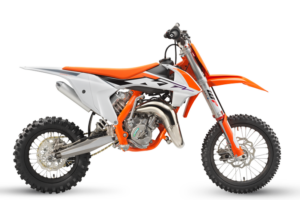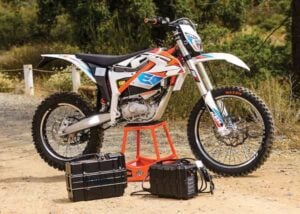We are reader-supported. When you buy through links on our site, we may earn an affiliate commission. Learn More…
Beginner’s Guide to Dirt Bike Jumping
Jumping a dirt bike for the first time is an exhilarating feeling that will stay with you forever, so being fully prepared for that first jump is essential. Every dirt bike rider remembers their first dirt bike jump because it can only go one of two ways: you either land, or you fall. To avoid the latter from being your first memory of jumping a dirt bike, this guide for beginners will teach how to safely prepare for taking jumps on a dirt bike. We’ll cover all aspects of jumping a dirt bike, from a breakdown of the necessary safety gear and preparations, to exploring the common types of jumps, before explaining riding positions and techniques that’ll help you jump safely with full confidence.

From freestyle motocross to enduro, nearly all sports disciplines with dirt bikes involve completing jumps of some kind. The well-known jumps that are found on motocross tracks are distinguishable due to their style, shape, length and height. Jumps provide a great opportunity to gain time or overtake other riders although they can pose a threat if the jump is overcrowded, the landing is obstructed, or the rider launches with poor positioning or technique.
The importance of wearing safety gear
Motocross, like any other motorsport, is dangerous – even for the pros. Dirt bikes travel at lower speeds compared with other two-wheeled disciplines, yet their ability to jump and soar through the air increases the likelihood of having an accident and potentially becoming injured.
To minimize the risk of serious injury while riding a dirt bike, the correct safety equipment must be worn while riding and the bike should be properly maintained and inspected before each ride. Learning to jump on a clapped-out bike adds a degree of danger that can be avoided.
Essential safety equipment to own
There is a vast selection of affordable protective clothing items available that will protect all major body parts from serious injuries. Because accidents can and do happen, we advise you refrain from learning to jump a dirt bike until you’ve got the follow safety equipment:
Helmet – Typically, motocross helmets are teardrop-shaped with a ‘beak’ at the top, facing forwards and an opening around the eyes and upper face for the option of goggles to be worn. The chin section normally contains vents as well as in various other locations on the helmet to allow cool air to enter. Only use helmets that have been rated and display safety markings and never use a helmet that is older than the stated lifespan, or one that has suffered an impact.
Goggles – Dirt bikes are a messy business. Dirt, sand, mud and dust particles consume the air, making it difficult to see and eye injuries can be excruciatingly painful. Dirt bike goggles are an affordable way to protect your vision and offer the flexibility of replacement lenses with tints to suit a medley of situations. Tear-off goggles are an evolution of the standard type which use a side-mounted scroll system that lets you easily discard a dirty lens for a clean, new one with a single motion.
Boots – Motocross and enduro style boots safeguard the toes, ankles and feet and usually feature soles with a special tread to increase grip on the footrests. Tall boots are the popular choice because they additionally offer shin and lower leg protection. Boots should be the correct size and adjusted and secured properly for a snug fit that allows a full range of movement.
Gloves – Due to the lower speeds and softer riding surfaces that dirt bikes are designed for, the types of gloves for dirt bikes are thinner, lighter and sleeker than leather motorcycle gloves and may also feature armor in the form of small nodes around the knuckles. The materials chosen are designed to improve traction on the grips and have breathable characteristics for airflow.
Back protector – Other than the head, the spine is the next vital body part that must be protected before hopping onto a dirt bike. The complex nature of the back muscles, nerves and small bones that form the spine make the back especially prone to serious injury that could have detrimental long-term effects. Back protectors come in many styles but typically protect the spine from overarching or impacts in the same way.
Neck protector – Under normal circumstances, the force on the neck from landing a dirt bike jump correctly does not pose any real danger to the neck or spine; but if the body is in a compromising position on impact, the neck is severely at risk of injury. Early forms of neck protection derived from karting resembled a U-shaped donut cushion that would prevent the wearer’s neck from reaching extreme angles that could cause a break of the neck or spinal cord. Neck braces are a much safer option that offer a higher degree of safety for the neck and spine.
Chest protector – A plate or multiple plates of impact-resistant material that are joined or woven together with straps to secure the plate around the rider’s body. Chest plates especially aim to prevent damage to the sternum, or breastbone, which can be fragile and easily broken in a harsh fall.
Protective pants/trousers – Motocross pants are loose-fitting to offer full freedom of movement on the bike and allow air to pass through the breathable material to cool the rider’s legs. Pants that have integrated knee armor are a popular option for those who prefer not to wear external knee pads.
Knee and elbow pads – Although rarely life-threatening, a knee or elbow injury can be very painful and has the potential to keep you from riding a dirt bike for a long time. The main difference between each type of elbow and knee pad is the type of modern impact-resistant material used in its construction.
Types of Dirt Bike Jumps on a Motocross Track
There are a variety of jumps you’ll find at a typical motocross track that each vary in size, proportion and difficulty – each requiring a unique approach to overcome and master. Learn and memorize the names of the jumps, noting their appearance from different angles so that you can easily identify them before taking to the track.
Common types of jumps explained:
Single dirt bike jump
The single dirt bike jump is the best place to start for a beginner with a simple up and down ramp. Practice on this jump can begin with taking the ramp slowly, maintaining both tires on the ground, before gradually increasing the entry speed on the up ramp to gain air before landing and completing the jump. Taking the jump faster increases the height, airtime and total distance of the jump.
Doubles
A double has two jumps that resemble a camel’s humps when viewed from the side. Despite having two jumps, doubles can be completed in a single passing if enough speed is carried to clear the gap between the first and second jump. Doubles can be a tricky jump in the beginning so work on gaining confidence by splitting the jump into two parts until the correct entry speed is found.
Triple jump
Exactly like doubles, only with an extra place to potentially jump to. Judging the entry speed correctly and visualizing the landing will ensure a clean landing. Clearing all three jumps usually requires plenty of speed and precise positioning when launching off the ramp.
Quads
Quads can be likened to doubles in the way they can be approached and are ideal for beginners to work on mastering their singles and doubles. Quads are versatile and can be easier to adapt to than doubles and triples.
Tabletop dirt bike jumps
Tabletops get their name from their flat-topped structure which forms a raised platform of dirt before the down ramp. Tabletops are great to begin with because they are usually wide enough to accommodate lots of riders and the tabletop itself allows you to gradually build confidence by trying to land further on the platform.
Whoops
A grill-like series of humps that exists on a flat section of the track. Whoops are the smallest kind of jump and function in a way unique to any other jump by causing the dirt bike to glide over the top at speed without gaining much air. Riding on whoops at a low speed lets the tires fall into the undulations causing the bike to shake violently, whereas a high speed causes the bike to lift and clear multiple whoops before touching down again. Rhythm and momentum are equally paramount overall speed to clear the whoops section as quickly as possible, as losing momentum part-way through loses significant time.
Step-up jumps
Step-up jumps are one of the first jumps every beginner dirt bike rider should try. They get their name from the fact that the second jump is located higher than the first, mimicking the effect of climbing stairs. Step-ups are normally easier for beginners than doubles, maybe because the higher second jump results in a short time in the air and a softer landing. Maintaining speed on the entry is essential to clear the gap and land on the second ramp.
Step-downs
Step-downs are the opposite of step-ups and resemble a double jump with a short, flat section between them. The key to successfully jumping a step-down is to control the speed as falling from height increases the speed carried.
Step-offs
A combination of a single, a gap to a step, and a final gap to another single. Step-offs offer the choice of landing on the step and then onto the second single or to clear the step by treating the jump as a double. There is nowhere to safely land between the jumps so care must be taken with choosing the landing wisely on approach.
Rollers
Rollers are simply larger whoops with deeper ramps that are spaced further apart, which causes the bike to jump over rather than glide over the bumps.
Dragon back dirt bike jump
The dragon back gets its name because it was said to look like the curved, jagged spines of a dragon’s back. The entry typically consists of three smaller jumps that send the rider over a gap, landing on a second jump located below. Visibility can be a problem with this type of jump as well as finding the correct positioning because there is little time to readjust your positioning once committed to the first few ramps.
Body positioning on a dirt bike
Dirt bike riding and jumping will have you switch between sitting and standing positions frequently to adapt to the changing nature of the course and its obstacles. Whether sitting or standing, some fundamentals, such as pinching the tank with your knees, riding on the balls of your feet and keeping your bodyweight centralized remain the same.
Now we’ll explain the characteristics and uses of the seated and standing body position on a dirt bike.
The seated position
- Place the balls of your feet on the footrests with both feet facing forward
- Pinch the gas tank with your knees to keep your legs close to the bike
- Arch your lower back slightly to keep your back straight
- Hold the grips with your thumbs turned slightly inward with your forearms aligned with your hands
- Raise your elbows up for easier control of the bars
Turns, berms and smooth, flat sections are typically where you can benefit the most from sitting on the seat.
The attack position
When done correctly, a neutral, standing body position allows the body a full range of movement which offers maximum control. This position is often referred to as the ‘attack position’ and follows the same principles except for the fact you are standing.
Standing-up on the dirt bike is best suited to jumping, landing and riding over whoops and uneven surfaces to prevent the suspension bottoming out or your bodyweight disrupting the balance of the bike.
Finding your first jump
As a beginner at a motocross track, you’ll most likely start by riding over the basic jumps lap by lap until you gain the confidence to attempt a jump at normal speed. In the beginning, start with a small and simple jump to practice such as a single, step-up, or tabletop. If you need help picking selecting a good jump for beginners at your local track, ask someone with experience to point you in the right direction.
Once you’ve decided on a jump, visit the area around the jump to check for any objects or hazards on the ground that might pose a risk if you were to jump. If you can, watch other riders taking on the jump to see the lines they choose on the exit and landing before you attempt it yourself. After checking the jump and surroundings are in a good state, you’re ready to begin jumping.
The jump in 5 steps:
- Ride to the up ramp with enough room to reach a suitable gear
- Towards the end of the up ramp, apply some extra throttle to compress the rear shock
- Stand in the attack position and lean forward before you leave the jump
- Keep the throttle steady on take off
- Bring your body back slightly in the air to return to attack position for landing
- Visualize where you want to land and keep the throttle on as you land
Common mistakes beginners make when jumping on a dirt bike
Practice to get to grips with the same jump until you get comfortable with the bike and can feel the changes in the bike’s behavior during each stage of the jump. Once you’re used to the basics of jumping, you can move on to the next set of tips and techniques that will help improve your jumping skill and prevent you from making the most common mistakes made by beginners when learning to jump a dirt bike.
Common mistakes when jumping on a dirt bike:
- Losing control due to a high wheel – A high wheel is when the front wheel loops into a wheelie unexpectedly, which can affect your landing with painful consequences. High wheels are commonly caused by sitting in the wrong position or overrevving the bike when you’re in the air. Applying the clutch then a touch of the rear brake will level out the bike and put you back in control.
- Landing with no throttle – Smooth throttle input throughout a jump is crucial for keeping the bike steady and balanced in the air. Landing without any throttle applied, or with too much throttle can cause the bike to crash in an endo or loop out. Land with steady throttle and your body in attack position for a clean landing.
- Injuring yourself on landing – Landing while leaning forwards or keeping too low to the bike on landing can lead to dangerous wipeouts and cause injury if contact is made with the handlebar, crossbar, or tank.
- Lacking commitment in jumps – Whether great or small, every jump requires the same commitment and composure to avoid the dangers of falling short of the landing or overshooting the jump. Set your vision on where you want the bike to go and take time to learn the ideal approach speed before trying to clear the gap.
- Landing with both wheels together – Often landing with the rear wheel first results in a softer landing vs with both wheels landing simultaneously. Landing with both wheels often means a higher likelihood of leading to a crash. With downhill gradient jumps, try to land with the front wheel first for better stability.
More tips and techniques for jumping
The key to cleaning up your jumps and learning how to get more height and air won’t come from grinding away if you don’t know the right techniques to work on. Throttle, rear brake control and body position are elements that need to be constantly sharpened – it’s not a matter of learning how to jump a triple and thinking the journey ends there.
Seat bouncing is a great technique to learn to gain more height and speed on your jumps. When you are sitting, make sure you have a straight back and that your weight is positioned over the rear wheel and shock, at right angles to the seat. Roll on a bit more gas for the final section of the up ramp to compress the rear shock and give the rear tire better traction for a better launch. Keep your knees pinched on the tank to avoid excessive seat bouncing and looping over in the air.
When you move on to longer, faster, and higher jumps, good practice for beginners is to visualize the jump in stages that represent places where you can safely jump and land. Take the time to get comfortable with the bike when taking on any jump and progress through each stage of the jump until you feel you’re ready to take on a challenging jump.
Before you attempt big and fast jumps, give your dirt bike a thorough shakedown, going over every major nut, bolt and clip to make sure the bike is safe and prepared to handle the forces of jumping more aggressively. If your bike’s suspension hasn’t been set up for you, it’s an adjustment we recommend for enhancing the responsiveness of your bike and allowing the suspension to work best with your weight.
How to prepare a dirt bike for jumping:
- Check and adjust tire pressures, inspect the tires for signs of damage
- Check the operation of any cables and lubricate them internally
- Tighten the front and rear axle to the correct torque setting
- Check the axle pinch bolt is secure
- Check the adjustment and tension of the chain to avoid excessive tightness or sag
- Check the bolts for the rear sprocket, brake calipers and chain rollers and guards
- Make sure all fluids, such as engine oil, coolant and brake fluid are fresh and topped up to the specified level
- Test the operation of the suspension and inspect the fork stanchions for leaking oil or damaged seals
- Test the wheels to see if there is any free movement or play from the wheel bearings
Conclusion
This guide to dirt bike jumping for beginners covers the key elements of dirt bike jumping that are essential to enjoying the sport responsibly, from safety measures and preparation, theory and practice of jumping, to control tips and techniques that will improve your jumping skill and prevent you making the common mistakes that stem from a lack of knowledge.
Because of the dangers associated with dirt bike riding, especially when jumping is concerned, investing in quality protective gear and wearing it whenever on the bike will help protect your body from harm and make controlling the bike easier and more comfortable.
Prior to taking jumps with more speed and aggression, first master the different body positions and understand how each can be used to your advantage in different situations. Jumps should always be approached in a standing position, unless seat bouncing, with the balls of your feet on the pegs, knees pinched on the tank and your back straight with high elbows.
The correct line, approach and entry speed must be reached when committing to a jump to avoid veering off course or suffering a bad landing. Inching into the jump until the full distance is reached is how you safely build your skills and confidence to jump the gap with success. Jumps take time to learn, and you shouldn’t expect to master a particular jump without practice and dedication.
Inspecting your protective gear is just as important as keeping up with maintenance on your dirt bike. Dirt bikes are extraordinarily capable machines that are thrilling to ride, but they only operate at their best and offer the expected standards of safety when cared for properly and inspected on a regular basis.
Get practicing and remember to keep yourself safe, remain aware of your surroundings and above all, enjoy what you are doing.
Resources






Be the first to comment